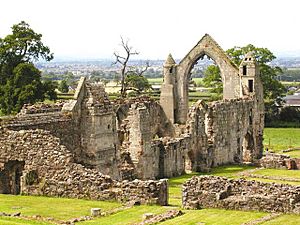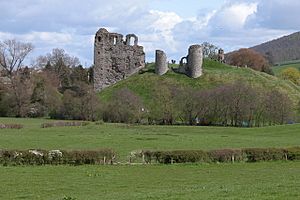Edmund Fitzalan, 2nd Earl of Arundel facts for kids
Quick facts for kids
Edmund Fitzalan
|
|
|---|---|

Froissart's Chronicles: Arundel and Hugh Despenser the elder before Queen Isabella
|
|
| Born | 1 May 1285 Marlborough Castle, Wiltshire |
| Died | 17 November 1326 (aged 41) Hereford |
| Cause of death | Executed |
| Resting place | Haughmond Abbey, Shropshire 52°43′57″N 2°40′47″W / 52.73249°N 2.67970°W |
| Title | Earl of Arundel |
| Tenure | 1306–1326 |
| Known for | Adherence to Edward II |
| Years active | 1306–1326 |
| Nationality | English |
| Residence | Arundel Castle |
| Locality | Welsh Marches, Sussex |
| Wars and battles | Scottish Wars Despenser War |
| Offices | Justice of Wales, Warden of the Marches of Scotland |
| Spouse(s) | Alice de Warenne |
| Issue | Richard Fitzalan, 3rd Earl of Arundel (among others...) |
| Parents |
|
|
|
|
Edmund Fitzalan, 2nd Earl of Arundel (born May 1, 1285 – died November 17, 1326) was an important English nobleman. He lived during a time of great conflict between King Edward II and his powerful nobles.
Edmund became the Earl of Arundel in 1306. He served King Edward I in wars against Scotland and was well rewarded for his loyalty. After Edward I died, Edmund first joined the nobles who opposed the new king, Edward II. He was even involved in the death of the king's close friend, Piers Gaveston. However, over time, Edmund became a strong supporter of King Edward II, especially because of his connection to the king's new favorite, Hugh Despenser the younger.
Edmund was given more land and important jobs for supporting the king. But his luck changed when Queen Isabella and Roger Mortimer invaded England in 1326. Edmund was captured and executed. His son, Richard, eventually got back the family's titles and lands a few years later.
Contents
Early Life and Family Connections
Edmund Fitzalan was born on May 1, 1285, at Marlborough Castle in Wiltshire. His father was Richard Fitzalan, 1st Earl of Arundel, and his mother was Alice of Saluzzo from Italy.
When Edmund's father died in 1302, Edmund was still a minor, meaning he was too young to manage his own affairs. He became a "ward" (someone under the care of a guardian) of John de Warenne, Earl of Surrey. Edmund later married Warenne's granddaughter, Alice.
In April 1306, just before his 21st birthday, Edmund officially received his father's title and lands. A month later, King Edward I knighted him. This knighting was a sign that Edmund was expected to serve in the wars against Scotland. He was greatly rewarded for his service, including having a large debt to the king forgiven.
Even after Edward I died in 1307, the new king, Edward II, continued to favor Edmund. In 1308, Edward II returned some land that Edward I had taken from Edmund's father. At Edward II's coronation in 1308, Edmund held the important role of chief butler, a traditional duty for the Earls of Arundel.
Standing Up to King Edward II
At first, King Edward II's reign seemed peaceful. But soon, many powerful nobles and church leaders began to oppose him. The main reason for their anger was the king's close friendship with a young knight named Piers Gaveston. Edward I had sent Gaveston away, but Edward II immediately brought him back.
The king showed too much favor to Gaveston, which offended the older, established nobles. Gaveston was even made an Earl, which was very upsetting to them. A group of powerful nobles, led by Henry de Lacy, Earl of Lincoln, forced Gaveston to leave England in 1308. However, Edward II soon made peace with the nobles, and Gaveston was allowed to return.
Edmund Fitzalan joined the group of nobles who opposed the king early on. He did not attend a meeting in 1309 where Gaveston's return was discussed. After Gaveston came back, he behaved even worse, and more nobles grew angry. People were also unhappy that Edward II was not continuing his father's wars against Scotland.
In 1310, the king had to agree to create a committee called the Lords Ordainers. This group of 21 powerful nobles, including Edmund, took control of the government to make reforms.
The Ordainers sent Gaveston away again in 1311, but he returned in 1312. By then, Gaveston was officially an outlaw. Edmund was among the earls who promised to find him. The leader of the opposition was now Thomas, Earl of Lancaster. In June 1312, Gaveston was captured, judged by Lancaster, Edmund, and other earls, and then executed.
Later, the king and the nobles made peace, and Edmund and the others received pardons. But bad feelings remained. In 1314, Edmund was among the nobles who refused to help Edward II in a war against the Scots. This contributed to England's terrible defeat at the Battle of Bannockburn.
Becoming Loyal to the King Again
Around the time of the Battle of Bannockburn, Edmund's loyalty began to shift back towards the king. Edward II had started to be more friendly with Edmund even earlier, forgiving his debts in 1313.
The most important reason for Edmund's change was a marriage agreement between his family and the king's new favorites, the Despensers. Hugh Despenser the Younger and his father, Hugh Despenser the elder, were slowly taking control of the government and using their power to get richer. While this made most nobles angry, Edmund's situation was different.
Around 1314 or 1315, Edmund's son, Richard, was promised in marriage to Isabel, the daughter of Hugh Despenser the Younger. With this connection, Edmund found himself back in the king's favor and began to receive rewards.
In 1317, he was made Warden of the Marches of Scotland, a key position protecting the border with Scotland. In 1318, he helped negotiate a peace treaty that temporarily settled the disagreements between the king and Thomas of Lancaster.
Edmund's new loyalty led to a conflict. In 1321, nobles demanded that Hugh Despenser and his father be sent away. The king, facing a rebellion in the Welsh Marches (border lands between England and Wales), had to agree. Edmund voted for their removal but later said he was forced to. He also supported their return a few months later.
Edmund had personally suffered during the rebellion when Roger Mortimer took his castle of Clun. In early 1322, Edmund joined King Edward II in a campaign against the Mortimer family. The rebellion quickly fell apart. The king then moved against Thomas of Lancaster, who had supported the rebels. Lancaster was defeated and executed.
After the rebellion, the Despensers became very wealthy from the lands taken from the rebels. Hugh Despenser the elder was even made an Earl. Edmund, now one of the king's main supporters, was also richly rewarded. After Roger Mortimer was captured in 1322, Edmund received Mortimer's lands in Wales.
He was also given important jobs. In 1323, he became the Chief Justiciar (a top judge and administrator) for North and South Wales. In 1325, he was made Warden of the Welsh Marches, responsible for gathering soldiers in Wales. He also strengthened his family's power through more marriages. In 1325, he arranged for two of his daughters to marry the sons of two of Lancaster's main allies.
Last Years and Death
In 1323, Roger Mortimer, who had been held in the Tower of London, escaped and fled to France. Two years later, Queen Isabella traveled to Paris. There, Isabella and Mortimer planned to invade England and replace Edward II with his young son, Prince Edward, who was with his mother.
Isabella and Mortimer landed in England on September 24, 1326. Because many people hated the Despenser family, few came to the king's aid. Edmund initially escaped with the king but was later sent to his lands in Shropshire to gather troops.
At Shrewsbury, he was captured by his old enemy, John Charlton of Powys. Edmund was then brought to Queen Isabella at Hereford. On November 17, 1326—the day after King Edward II was captured—Edmund was executed. It is believed that Mortimer ordered his death.

Edmund's body was first buried at a church in Hereford. However, he had wished to be buried at his family's traditional burial place, Haughmond Abbey in Shropshire, and he was later moved there.
Although he was never officially declared a saint by the church, people began to greatly admire and honor Edmund in the 1390s. They saw him as a "martyr" (someone who dies for their beliefs). This honor might have been inspired by a similar admiration for his grandson, Richard FitzAlan, 11th Earl of Arundel, who was executed by Richard II in 1397.
When Edmund was executed, he "attainted," meaning he lost his titles and property because of a crime against the king. His lands were taken by the crown, and much of it was given to Isabella and Mortimer.
Edmund Fitzalan's son, Richard, tried to rebel against the crown in 1330 but failed and had to flee to France. In October of that year, King Edward III took power from Isabella and Mortimer. This allowed Richard to return and reclaim his family's inheritance. On February 8, 1331, he was fully restored to his father's lands and became the Earl of Arundel.
Children
Edmund and Alice had at least seven children:
| Name | Birth date | Death date | Notes |
|---|---|---|---|
| Richard Fitzalan, 3rd Earl of Arundel | c. 1313 | 24 January 1376 | Married (1) Isabel le Despenser, (2) Eleanor of Lancaster |
| Edmund | — | c. 1349 | |
| Michael | — | — | |
| Mary | — | 29 August 1396 | Married John le Strange, 4th Baron Strange of Blackmere |
| Aline | — | 20 January 1386 | Married Roger le Strange, 5th Baron Strange of Knockin |
| Alice | — | 1326 | Married John de Bohun, 5th Earl of Hereford |
| Katherine | — | died 1375/76 | Married (1) Henry Hussey, 2nd Baron Hussey, (2) Andrew Peverell |
| Eleanor | — | — | Married Gerard de Lisle, 1st Baron Lisle |
| Elizabeth | — | — | Married William Latimer, 4th Baron Latimer |
Sources
|
Edmund Fitzalan, 2nd Earl of Arundel
FitzAlan
Born: 1 May 1285 Died: 17 November 1326 |
||
| Peerage of England | ||
|---|---|---|
| Preceded by Richard Fitzalan |
Earl of Arundel 1302–1326 |
Succeeded by Richard Fitzalan |


